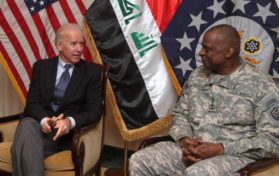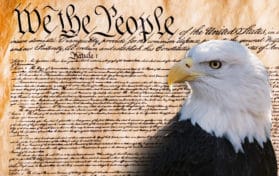
The United States is seeing a dramatic rise in the number and strength of loosely-affiliated far-right militia movements. Although many groups have different core values, common causes between groups are white supremacy, gun rights, and the rejection of federal or even state authority. Some of the most theoretically developed groups are described as the sovereign citizen movement, which evolved from the posse comitatus movement and rejects the government’s authority to tax its citizens. Many groups preach conspiracy theories involving the takeover of the federal government by Jews and a secret global Zionist government. Clashes between these groups and the government have often proven violent, especially due to the militia movement’s support for gun rights and its glorification of revolution against a tyrannical government. Militia chapters are often rurally based and meet frequently to drill with firearms. Because this is a legal activity explicitly protected in the 2nd Amendment, it can sometimes be difficult for government officials to differentiate between relatively peaceful militias and ones that actually plot violence or revolution.
Domestic Terrorism Threats
The FBI considers the sovereign citizen movement the nation’s top domestic terrorism threat. This was a more widely held belief in the 1990s after several infamous clashes between the government and militias, but a decade of radical Islamist terrorism overshadowed domestic US terrorism. Now, the election of a black president, a decreasing percentage of the country identifying as white, and the nation’s steady trend towards secularization has again emboldened the movement. The Southern Poverty Law Center found that the number of radical militias grew to 1,360 in 2012, up 80% since 2008. It is no secret that gun sales have surged through Obama’s presidency, leading some to refer to him as the “greatest gun salesman of all time.” As the nation’s attention turns away from the Middle East, domestic militia movements may become the greatest perceived threat to national security.
In the last few years, there have been several examples of domestic terrorism. In 2010, in response to a case of extremism against the federal government, federal forces raided a Christian militant group in Michigan, Ohio, and Indiana called Hutaree. The Hutaree took inspiration from the Bible, quoting passages on its website and asserting that “Jesus wanted us to be ready to defend ourselves using the sword…” As a result of these raids, nine members of the armed group were charged with seditious conspiracy and attempting to deploy weapons of mass destruction. The group had allegedly planned to attack a law enforcement officer, then detonate explosives at the would-be funeral procession, where more officials would gather. The group targeted federal government employees, especially law enforcement, and accumulated weapons and explosives for its goals.
Perhaps the most famous case of domestic terrorism is the 1995 Oklahoma City bombings. An ex-army soldier named Timothy McVeigh parked a truck containing a powerful bomb outside a Federal Building in downtown. The explosion destroyed much of the building, incinerated cars, and more than 300 buildings in the vicinity were damaged or destroyed. This was the worst case of homegrown terrorism in US history, killing 168 people and injuring hundreds of others.
Land Disputes
Recently, domestic terrorism has made the news because of the activities of Cliven Bundy. Although tensions between Cliven Bundy and the federal Bureau of Land Management (BLM) go back two decades, the conflict that produced an armed standoff this month commenced with an August 2013 federal court ruling ordering Bundy to remove his cattle from federal lands. In October 2013, a federal district judge warned Bundy not to physically resist the federal government.
Nothing worth noting happened until March 15, 2014, when the BLM told Bundy that they were going to impound his cattle. By March 27, the BLM had closed off 322,000 acres of public land in preparation for the cattle impoundment. Cliven Bundy appealed to the county sheriff, asking for protection from what he deemed a hostile threat to his property. On April 1, Bundy’s children and grandchildren, numbering over sixty-five people in total, assembled at his home, ready to resist the BLM. Also on April 1, the BLM established two “First Amendment Areas” in Bunkerville, Nevada. Protesters were limited to those designated areas, an action that Nevada Governor Brian Sandoval called “most disturbing,” an action that “trample[d] upon Nevadans’ fundamental rights under the Constitution.” On April 2, protesters arrived at the auction house where Bundy’s cattle, soon to be impounded by the BLM, were to be sold.
On April 5, the impoundment of Bundy’s cattle began. The situation became tenser the following day, when one of Bundy’s sons was arrested for resisting authorities. On April 9, two of Bundy’s family members were injured in a physical altercation with federal officers. On April 10 the “militia” formed. Supporters from the local community, as well as from neighboring states, joined Bundy and his family with arms and supplies. Women and children formed a sort of “human shield,” standing between the armed men and the federal officials.
On April 12 the standoff ended, with the BLM withdrawing and the cattle impoundment concluding. Bundy and his family declared victory; others, including some of Bundy’s neighbors, the BLM, and Senate Majority Leader Harry Reid, expressed dismay over the capability of an armed militia to supersede the rule of law. The BLM made clear, however, that this conflict is not yet over. Since then, Bundy has come under fire for racist comments that he made while being videotaped.
Militias
If there seem to have been growing reports of sovereign citizen cases and militia movements in recent years, it would be because more people are paying attention to their messages. The same sentiment that drove the Bundy rebellion rose and fell throughout the past century in the West, most notably during the “Sagebrush Rebellion” of the Seventies. Whereas that movement was primarily political, in which state legislators lead the call for control of Federal land, the Bundy rebellion took advantage of a decentralized network of militants. A letter drafted by Bundy quickly spread through right-wing organizations, and to coverage on social networks and right-wing blogs.
Ideology aside, the world has also changed in the sovereign citizens’ favor. With the average American squeezed both by higher debt and economic pressures, more people are willing to try sovereign citizen strategies to escape financial calamity. (One sign of this is when actor Wesley Snipes tried to use sovereign citizen arguments in his tax fraud case.) Certain changes spurred by the Obama administration – namely health care reform and greater EPA regulations – are tied into a narrative of statist and environmental groups usurping power, a narrative buttressed repeatedly by right-wing media. Militancy as a political strategy is slowly gaining legitimacy. Unless political institutions can come to a consensus and regain some credibility, more people will attempt a desperate shot against the government – and perhaps kill in the process.
Contributions By Alexi Stocker, Tom Cui, Monika Hur, and Sam Houskeeper





